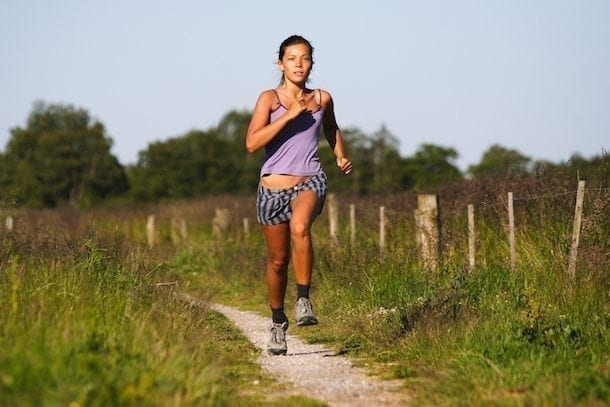Having trained for three marathons and roughly two-dozen half-marathons, I’ve done my fair share of hot, sweaty summer runs. Running in the heat can be perfectly safe—and it doesn’t feel so miserable when you’re mentally prepared, or have a cool pool to jump in after! Still, it’s important to remember that just because you can run outside, doesn’t mean you should. Here’s how to run safely when the temperature creeps up.
1. Dress for the heat Skip your favorite black t-shirt and capris in favor of light- colored tops and shorts made with light weight, sweat-wicking fabrics. That goes for your socks, too. Feet can be especially sweaty in hot temperatures, and the last thing you need is a blister. (Bonus points if your gear offers built-in sun protection—look for labels with “UPF” ratings.)
2. Hydrate before heading out The American College of Sports Medicine recommends drinking 1 ounce of water for every 10 pounds of body weight 4 hours before running. And if you think you’ll be sweating profusely (remember, it’s hot out there!), you should sip an additional .6 ounces for every 10 pounds of body weight 2 hours before a run. Which means, if you weigh 150 pounds, you need guzzle 24 ounces before lacing up your sneakers. Be sure to stop by the bathroom before walking out the front door.
3. Carry water with you Don’t count on the water fountains along your route to be operational! On short summer runs, I carry a hand-held water bottle and take a sip every few minutes. Longer runs require more liquid (even if you hydrated before leaving the house!), so consider investing in a hydration belt or backpack.
4. Replace your electrolytes Water isn’t the only thing you lose when your body sweats. Electrolytes can seep out, too. During a typical workout, for every liter of sweat a runner can lose 460 to 1840mg of sodium, 710 to 2840mg of chloride, 160 to 390mg of potassium, 0 to 36mg of magnesium, and 0 to 120mg of calcium. If you’re a particularly “salty” sweater or prone to cramps in the heat, you’ll want to carry a sports drink or add electrolyte tablets to your water bottle. Otherwise, sipping an electrolyte-filled beverage post-run should do the trick.
5. Stay in the shade A little tree cover makes a big difference in the heat of summer. Try to avoid direct sunlight by running in the morning or in the evening, and consider trading in your usual neighborhood route for a woodsy trail or a park with lots of shade.
6. Get up even earlier Waking up to a blaring alarm clock stinks, but so does running in the heat of the day. If you hit the pavement before the sun comes up, you’ll be able to complete your run when it’s still cool. And, if you time is perfectly, you might be able to slip in a post-shower nap before heading to work.
7. Cut back the distance You may have been planning a long run, but if half way through you find yourself feeling dehydrated or light headed, stop! You can always run more tomorrow, or finish your workout indoors.
8. Know when to go inside Everybody tolerates heat differently. For me, I get cranky and pretty much can’t function when the thermostat hits 90 or above. If you don’t have a shady path nearby, consider heading to a local fitness center to do your run on a treadmill. Yes, it’s boring in there, and no, it doesn’t feel the same as pavement, but being able to get in a couple miles in a cool 70 degrees feels pretty good on those dog days of summer.
How do you stay cool during outdoor summer workouts? Share your tips in the comments!
UPDATE: June 15, 2014—An earlier version of this article incorrectly stated the body could incur a loss 0 to 120 grams of calcium in one liter of sweat. The correct amount is 0 to 120mg of calcium per liter. We apologize for any confusion.




